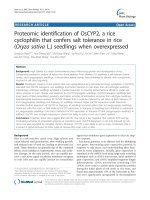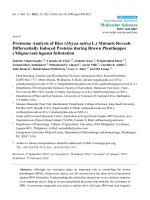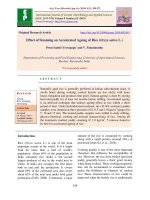Genotypic variation in response to aerobic conditions of rice (oryza sativa l )
Bạn đang xem bản rút gọn của tài liệu. Xem và tải ngay bản đầy đủ của tài liệu tại đây (729.26 KB, 138 trang )
Genotypic Variation in Response to Aerobic
Conditions of Rice (Oryza sativa L.)
Nguyen Thi Ai Nghia
2015
Genotypic Variation in Response to Aerobic
Conditions of Rice (Oryza sativa L.)
A dissertation submitted in partial fulfillment of the
requirement for the degree of Doctor of Philosophy
by
Nguyen Thi Ai Nghia
Agricultural Ecology
Graduate School of Bioresource and Bioenvironment Sciences
Kyushu University
Japan
2015
TABLES OF CONTENTS
i
TABLES OF CONTENTS
LIST OF ABBREVIATIONS
iii
ABSTRACT
iv
CHAPTER I: General introduction
1
CHAPTER II: Genotypic variation in morphological, physiological and
agronomical characteristics of rice under flooded and aerobic
conditions
Section 1: Genotypic variation in morphological and physiological
characteristics of rice under flooded and aerobic conditions
Introduction
11
Materials and methods
14
Results
19
Discussion
26
Section 2: Genotypic variation in yield and yield components of rice under
flooded and aerobic conditions
Introduction
41
Materials and methods
42
Results
43
i
Discussion
47
CHAPTER III: Mapping QTLs for root traits under aerobic condition of
doubled haploid (DH) population derived from a cross between
Koshihikari and Sensho
Introduction
55
Materials and methods
57
Results
59
Discussion
64
CHAPTER IV: Aquaporin expressions of rice roots under flooded and
aerobic conditions
Introduction
84
Materials and methods
87
Results
88
Discussion
90
98
CHAPTER V: General discussion
ACKNOWLEDGEMENTS
103
REFERENCES
105
ii
LIST OF ABBREVIATIONS
DAS: Days after sowing
FRL: Fine root length
FTRR: Fine to thick root ratio
gs: Stomatal conductance
L0: Hydraulic conductance
LWP: Leaf water potential
PH: Plant height
RSR: Root to shoot ratio
RD: Root diameter
RDW: root dry weight
RL: Root length
RSA: Root surface area
RV: Root volume
SDW: Shoot dry weight
SMC: Soil moisture content
TN: Tiller number
TRL: Thick root length
TDW: Total dry weight
WU: Water uptake
WUE: Water use efficiency
iii
ABSTRACT
Chapter II
Genotypic Variation in Morphological, Physiological and Agronomical
Characteristics of Rice under Flooded and Aerobic Conditions
Aerobic rice system is a new promising water-saving cultivation
technique; however, rice sensitivity to aerobic conditions limits its use. We
investigated morphological, physiological and agronomical responses of two
upland rice genotypes (Beodien and Sensho) and two lowland rice genotypes
(KD18 and Koshihikari) to flooded condition (control) and three aerobic
conditions (32%, 22%, and 14% soil moisture content (SMC), w/w) in 2013
and to flooded condition and aerobic condition (32% SMC) in 2014. Under
aerobic conditions, shoot growth was limited because of a reduction in water
uptake. Water uptake capacity was highly controlled by root traits such as root
dry weight and root length. Under aerobic conditions, leaf water potential,
stomatal conductance, and root hydraulic conductance declined. We found that
32% SMC condition was the most favorable aerobic condition whereas 22%
and 14% SMC conditions strongly suppressed rice growth. In both years,
cultivar Sensho adapted to 32% SMC condition, whereas Koshihikari was not
suitable for aerobic rice system, probably because of its limited root growth
and lower root plasticity. As a consequence, Sensho archived higher shoot
biomass and therefore yield than Koshihikari under 32% SMC condition. Our
iv
results also confirm that root traits are important for improving rice
performance under aerobic rice system.
Chapter III
Mapping QTLs for Root Traits under Aerobic Condition of Doubled
Haploid (DH) Population derived from a Cross
between Koshihikari and Sensho
A double haploid population from a cross between two japonica
genotypes, Koshihikari and Sensho, were used to identify the genetic
background of root traits under two water regimes: flooded and aerobic
condition (32% SMC (w/w)). Total 26 quantitative trait loci (QTLs) were
detected on chromosomes 2, 3, 4, 5, 6, 7, 8, 9, 10 and 11, which explained
12.3– 24.8% of total phenotypic variation. The consistency of some QTLs
across mapping populations and some QTLs that co-localized with some major
QTLs found in this study should be good candidates for marker-assisted
selection (MAS) in breeding program. Especially, two QTLs for relative RSR
on chromosome 9 would be the important QTLs for further studies. Moreover,
the significant correlations between root traits such as RDW, RL, RSA and RV
with WU, SDW and TDW indicated that these root traits may play an
important role in water uptake ability and plant growth especially under
aerobic condition.
v
Chapter IV
Aquaporin Expressions of Rice Roots under Flooded and Aerobic
Conditions
Aquaporin play a crucial role in plant water uptake and transport. To
understand the root aquaporin expression and their correlation with root
hydraulic conductance, 9 plasma membrane instrinsic proteins (PIPs) and four
tonoplast intrinsic protein (TIPs) were studied in upland rice “Sensho” and
lowland rice “Koshihikari” under flooded and aerobic conditions (32% SMC
(w/w)). Four-week rice seedlings were used for analysis of root hydraulic
conductance (L0) and root aquaporin expressions. As a result, root L0 was
higher in Sensho than Koshihikari under all conditions. OsPIP1;3 showed most
abundant under flooded condition. While the transcript levels of OsPIP2;1,
OsTIP1;1 were up-regulated under aerobic condition in both rice genotypes.
Especially, OsPIP2;1 was up-regulated more than 10-fold in Sensho under aerobic
condition and it was about two times higher than that of Koshihikari. Other genes,
such as OsPIP1;3, OsPIP2;2, OsPIP2;5, OsTIP1;2, OsTIP2;1 and OsTIP2;2
were down-regulated in both rice genotypes under aerobic condition. We
concluded that OsPIP1;3, OsPIP2;1 and OsTIP1;1 may play an important role on
root water uptake; additionally, up and down-regulated of 8 PIP and 4 TIP genes
may be linked with root L0 of rice under aerobic conditions.
vi
CHAPTER I
GENERAL INTRODUCTION
Food demand is increasing with rapidly growing world population. The
global population is grown from 6.2 billion people in 2002 to 8.2 billion people
in 2050 (Rockstrom 2003). It is estimated that, by the year 2025, 60% more
rice than currently rice production is necessary to produce to meet the food
demand of growing world population (Zhang et al. 2009). Rice is the most
major staple food in Asia, where it provides 45%–70% of total calorie intake
for nearly half of world population (IRRI 2013). Rice is grown in wide range
of climate. Rice is cultivated in 125 million ha over the world, account for 9%
of world land cultivated area where 57% is irrigated; 32% is rainfed lowland;
9% is upland and 2% is deepwater (IRRI 2013). Among these, irrigated rice
provides 75% rice supply thus Asia’ present and future food security depends
largely on the irrigated rice production system (Bounman 2001).
However, nowadays,
the
global “water crisis”
threatens the
sustainability of irrigated rice (Bounman 2001). Water shortage for agricultural
irrigation worldwide due to competition from urban and industrial
development, degraded irrigation infrastructure, water pollution and climate
change (Postel 1998; Hanjra and Qureshi 2010). In Asia, irrigated agriculture
accounts for 90% of total diverted freshwater and more than 50% of this is
1
used to irrigated rice (Bounman 2001). Thus irrigated rice is the main
consumption of water irrigation. Generally, decreasing water availability for
agriculture threatens the productivity of the irrigated ecosystem, and ways must
be sought to increase grain yield and water use efficiency of rice (Guerra 1998;
Belder et al. 2004; Yang et al. 2007).
Vietnam is the Southeast Asia country where rice is major staple food
and grown in all regions. Total land area for rice production in Vietnam is
about 4.2 million ha (Denning and Vo 1994). In two decades 1980s and 1990s,
Vietnam has shifted from a chronic food deficit to become the second world
largest rice exporter (Tran and Kajisa 2006). Vietnam divides into seven-major
rice- growing regions which are North Mountain Highlands (NMH), Red River
Delta (RRD), North Central Coast (NCC), South Central Coast (SCC), Central
Highlands (CH), North East South (NES) and Mekong River Delta (MRD)
(Fig. 1-1). Among these, RRD and MRD are irrigated and intensive rice
ecosystems where rice is cultivated 2-3 seasons per year with various cropping
pattern. RRD and MRD occupy 61% of total rice area and contribute about
65% of rice output. In contrast, NCC and SCC are considered as less favorable
regions, occupying 19% of total rice area and contributing about 17% of
output. The remaining rice produced in Vietnam is rainfed lowland or upland
rice in the mountainous and highland areas such as NMH and CH which have
significant geographical difficulty in increasing irrigated area, being considered
as least suitable for rice cultivation (Young et al. 2002; Tran and Kajisa 2006)
2
(Table 1-1). However, rice is the major subsistence crop for about 52 ethnic
minority groups living in these areas. In these areas, upland rice is still grown
with area of 0.5 million ha accounting for 8% of total rice area in Vietnam.
Most upland rice farmers practice shifting cultivation based on slash-and-burn
(Pandey and Dang 1998) and yield remains low ranging from 0.6 to 2.0 tons
ha-1 (Nhan 2006). Moreover, in last decade, drought happened in winter-spring
season in various years, such as 1959, 1961, 1970, 1984, 1986, 1989, 1993 and
1998 that had damaged many kind of crops; especially in 1988, 1993 and 1998,
drought occurred on a national scale (ADPC). Drought in winter-spring season
is coincided with seedling stage of spring rice. Drought were recorded to
happen more frequently in NMH, NCC, SCC, CH and MRD (Nguyen et al.
2005). In 2004, drought occurred in 8 provinces of NMH region with estimated
loss of 80 million dollars and affected more than 1 million citizens (Nguyen et
al. 2013). Additionally, drought in MRD region often comes together with
salinization that causes more damages to crops and soil (ADPC). Therefore,
aerobic rice with water-saving strategy will become a very important factor for
Vietnam to consider in the future, with climate change.
Water scarcity requires new ways of thinking about, using and
managing water. In irrigated lowland rice, the high water demand mainly arises
from keeping a permanent water layer on the field (Guerra et al. 1998; Belder
et al. 2005a; Yang et al. 2007). The ponded water layer causes loss of water
through evaporation, seepage and percolation. To reduce water use in irrigated
3
lowland rice and to cope with water shortage, water-saving techniques are
being developed that include direct (dry) seeding (Tabbal et al. 2002); keeping
soils at saturation (Borrell et al. 1997), and keeping field alternate wetting and
drying (AWD) (Bounman and Tuong 2001; Belder et al. 2005a). And a new
development of water-saving techniques is “aerobic rice” (Bounman 2001;
Bounman et al. 2005). Aerobic rice have been studied recently in China (Yang
et al. 2005) and at International Rice Research Institute (IRRI) (Lafitte et al.
2002; Bounman et al. 2005). Aerobic rice is the attractive option of farmers in
irrigated areas where water is too scarce or expensive to grow lowland rice or
in rainfed areas where rainfall is insufficient to allow lowland rice production,
but sufficient for aerobic rice in favorable upland areas where supplementary
irrigation is available (Bounman et al. 2005, Parthasarathi et al. 2012). In
aerobic rice system, rice is grown in nonflooded and nonsaturated aerobic soil,
like an irrigated upland crops such as wheat and maize (Bounman 2001;
Bounman et al. 2006). Irrigation is applied to bring the soil water content in the
root zone up to field capacity only when it has reach a certain lower threshold
(Bounman 2001). Aerobic rice systems could reduce water inputs by 11.5 to
50.7% in the Philippines (Belder et al. 2005a; Bouman et al. 2005), by 29.2 to
65.3% in northern China (Bouman et al. 2006; Yang et al. 2005), and by 62.5
to 70.8% in Japan (Matsuo and Mochizuki 2009) as compared with flooded
paddy conditions. However, aerobic rice yield was 22-32% lower than
conventional (flooded) lowland rice yields (Bounman et al. 2005). Therefore it
4
is important to develop new aerobic rice varieties that combine drought
resistance of upland rice and high yield of lowland rice (Lafitte et al., 2002).
Adjustment of plant to drought may involve several mechanisms such
as drought escape, dehydration avoidance, dehydration tolerance and drought
recovery (Fukai and Cooper 1995). Each mechanism may be the interaction of
number of traits. Drought escape is effective tool of crop to minimize effects of
terminal drought stress by short crop duration. Because reproductive stage is
the most susceptible to drought stress of therefore quick-maturing cultivars are
often more alleviative to terminal stress than late-maturing cultivars.
Dehydration avoidance is a mechanism for avoiding low water status during a
drought period. This can be achieved both by extracting more water from the
soil and by using water slowly during the early stages of drought period so that
more is available in the later period (Fukai and Cooper 1995). Thus, cultivars
with root systems develop largely and deeply can capture more water from soil
or cultivar that closing their stomata during stress or having a non-permeable
leaf cuticle can save water transpiration from canopy are considered as
dehydration avoidance varieties (Luo 2010). Dehydration tolerance is defined
as capacity of plants to maintain function under low leaf water potential. The
active accumulation of osmotic adjustment in plant cells maintain a high
turgor. It also includes capacity enhancement in the removal of harmful
substances accumulated in plants and anti-oxidation, etc (Luo 2010). This
response are based on complex physiological traits such as osmotic adjustment,
5
ABA content, proline content, soluble sugar content, etc (Cazares et al. 2010).
Drought recovery is an important mechanism when drought occurs early in
crop development. Ability to produce more tiller and retain green leaves during
and after drought stress is important because it can supply more assimilate to
the development during subsequent recovery (Fukai and Cooper 1995).
Several traits were identified to confer to drought resistance in rice that
may be divided into primary, secondary, integrative, phenological and planttype traits (Kamoshita et al. 2008). Primary traits are further divided into
constitutive traits (e.g., rooting depth, root thickness, branching angle and root
distribution pattern) (Lafitte et al. 2001; Kato et al. 2006) and induced traits
(e.g., hardpan penetration and osmotic adjustment). Root depth and extension
into deep soil is beneficial under drought when moisture is available at deeper
soil layer. Genotypes that have deep, coarse roots with a high ability of
branching and penetration, higher root to shoot ratio, elasticity in leaf rolling,
early stomatal closure and high cuticular resistance are considered as drought
avoidance mechanism (Blum et al. 1989; Samson et al. 2002; Wang and
Yamauchi 2006). Constitutive root traits, interacted with drought intensity,
have a large effect on extractable soil water during drought (Lilley and Fukai
1994a), therefore influences expression both induced and secondary traits such
as maintenance of plant water status, canopy temperature, leaf rolling score and
leaf death score. These secondary traits may then reduce spikelet fertility and
yield component (i.e., integrative traits). Plant-type traits such as tiller number
6
and plant height modify the expression of secondary and integrative traits by
affecting transpiration demand. Genotypes with greater plant height often have
larger plant size, intercept more light and use water faster by transpiration,
leading to lower plant water status (Kamoshita et al. 2004), higher leaf death
score and more spikelet sterility (Pantuwan et al. 2002b; Kato et al. 2007b).
Phenology, interacted with timing of drought, has a large effect on yield
through integrative traits. Plant-type traits (e.g., plant height) and phenology
(e.g., flowering time) usually are highly heritable and are extensively used in
traditional plant breeding (Cooper et al. 1999a,b). The greater the delay in
flowering, the greater the yield and harvest index reduction due to drought has
been reported by Pantuwan et al. (2002a). Leaf rolling and canopy temperature
(i.e., secondary traits) are also useful for quickly screening hundreds of lines
(Lafitte et al. 2004; Hirayama et al. 2006).
Lian et al. (2004) found that upland rice and lowland rice showed
different physiological responses to water deficit that confirmed that upland
and lowland have different mechanisms for drought resistance. Upland rice
traditionally showed drought avoidance (Price et al. 1997, Price et al. 2002a),
yield is stable but low under aerobic conditions (Laffite et al. 2002) whereas
high-yielding lowland rice genotypes grown aerobically showed severe yield
penalty (Blackwell et al. 1985; McCauley 1990; Westcott and Vines 1986).
Several studies also showed that upland rice cultivars posses deeper root
system therefore extracted more soil water during drought (Lilley and Fukai
7
1994b; Kato et al. 2007a). Comparison between upland rice and lowland rice
could make a deeper understanding of plant adaptation mechanisms to drought
(Lian et al. 2004).
Previous studies of aerobic rice systems have focused on comparing
morphological and physiological traits such as root parameters, shoot dry
weight, root dry weight, stomatal conductance, yield and yield components of
aerobic rice with those observed under flooded paddy conditions (Bouman et
al, 2005; Matsuo and Mochizuki, 2009; Matsuo et al. 2010). In these
experiments, genotypic variation of different rice genotypes in response to
aerobic conditions were determined. First, the morphological, physiological
and agronomical characteristics of different rice varieties were compared under
flooded and aerobic conditions in Chapter II. Next, QTLs for root traits of
double haploid population derived from a cross between Koshihikari and
Sensho was presented in Chapter III. Finally, aquaporin expressions of rice
roots of two japonica rice genotypes, Sensho and Koshihikari, under flooded
and aerobic condition were analyzed in Chapter IV.
8
(N
(R
(N
(S
(C
(N
(
Fig. 1-1. Seven agro-ecological rice-growing regions of Vietnam
9
Table 1-1. Changes in irrigated rice area by major ecological regions in
selected years from 1980 to 2002.
Rate of irrigated area (%)
Year
Whole
NMH
RRD
NCC
SCC
CH
NES
MRD
country
1980
46
50
75
53
31
10
9
41
1985
49
49
73
53
37
13
14
46
1990
55
55
80
60
48
18
20
52
1995
64
58
89
71
52
22
27
64
1998
68
59
91
76
64
30
36
67
2002
85
57
100
80
88
41
69
91
NMH: North Mountain Highlands
CH: Central Highlands
RRD: Red River Delta
NES: North East South
NCC: North Central Coast
MRD: Mekong River Delta
SCC: South Central Coast
10
CHAPTER II
Section 1:
Genotypic Variation in Morphological and Physiological Characteristics of
Rice under Flooded and Aerobic Conditions
Introduction
Rice is the major staple food in Asia and provides 45–70% of total caloric
intake in many rice-consuming countries. Approximately 75% of rice supply
comes from 93 million ha of irrigated lowland rice (IRRI 2013). Therefore,
irrigated lowland rice plays an important role in food security in Asia. However,
nowadays, with the increasing water scarcity worldwide, the sustainability of the
irrigated lowland rice system is being threatened by water deficit. Various watersaving cultivation techniques have been developed to cope with water shortage,
including the relatively new aerobic rice cultivation technique. In this technique,
rice is grown in non-puddled and non-saturated soils, similar to wheat and maize
cultivation (Bouman 2001; Bouman et al. 2005), which could save water by
minimizing seepage and percolation, and greatly reducing evaporation
(Bouman et al. 2002). Therefore, this technique holds promise for farmers in
the regions where water is too scarce or too expensive to grow flooded lowland
rice (Bouman et al. 2005).
11
In irrigated lowland rice, a standing water layer is maintained in the field
for most of the season when water and nutrient supply is favorable for rice
growth. In aerobic rice, irrigation is applied to bring the soil water content up
to field capacity when a lower threshold has been reached, such as halfway
between field capacity and wilting point (Doorenbos and Pruit 1984; Bouman
2001; Bouman et al. 2005); thus, rice plants might suffer a small water deficit
between irrigation events (Okami et al. 2014). Rice is vulnerable to even a
small loss of available water (Nguyen et al. 2009). Under aerobic conditions,
stomata close and transpiration declines even when the soil moisture potential
at the 20-cm depth is near field capacity (Kato and Okami, 2010, 2011). As a
consequence, rice yield is considerably reduced in aerobic culture in
comparison with flooded culture (Belder et al. 2005; Bouman et al. 2005; Peng
et al. 2006; Matsuo and Mochizuki 2009). Additionally, new rice genotypes
adapted to aerobic soil and occasional water deficit are required (Atlin et al.
2006). Therefore, studies of physiological and morphological responses of rice
under aerobic conditions could provide necessary information for breeding
programs.
The root system is an important trait for increasing yield under soilrelated stresses (Serraj et al. 2004; Lynch 2007). Rice is a shallow-root crop
susceptible to drought (Yoshida and Hasegawa 1982). To adapt to aerobic
conditions, rice roots undergo morphological and anatomical changes (Kato
and Katsura 2014); in particular, root growth becomes restricted (Kato and
12
Okami 2010, 2011; Kato et al. 2010). Water absorption by the root system is
determined by root hydraulic conductivity and total root length (or root surface
area) (Kato and Okami 2011; Kato and Katsura 2014). Under aerobic
conditions, total root length is considerably reduced due to down-regulation of
adventitious root emergence and lateral root branching (Kato and Okami
2011). Root hydraulic conductance tended to decrease under aerobic conditions
(Matsuo et al. 2009). Restriction in water uptake capacity might make rice
plants vulnerable to aerobic conditions (Kato and Okami 2011). Therefore,
improving rice root traits (e.g., root mass and function) could enhance plant
adaptation to aerobic rice system.
Although aerobic rice could save water but some risks of poor
performance (Kato et al. 2009) and yield penalty (Matsuo and Mochizuki
2009) due to reduce water utility in aerobic conditions (Belder et al. 2005; Kato
and Okami 2010). Therefore, the favorable aerobic condition should be applied
to mitigate these disadvantages. However, there were few studies about effect
of soil moisture condition on growth of rice under aerobic rice system.
Previous study have focused on comparing morphological and physiological
response under mild water stress aerobic conditions (Mastuo et al. 2010). And
some other studies conducted under severe aerobic conditions (Belder et al.
2005; Bouman et al. 2006). In this study, the author conducted two
experiments in two years, 2013 and 2014. In 2013, the author grew rice under
flooded and three aerobic conditions (including severe water tress, mild water
13
stress and well-irrigated conditions) and found out the genotypic variation in
physio-morphological traits were clearly observed under well-irrigated
condition. Therefore, in second year, the author focused to compare
morphological and physiological response in two conditions: flooded and wellirrigated conditions. Comparing growth of rice between flooded and wellirrigated condition is necessary for improving water management technique as
well as breeding of aerobic-adapted varieties.
Materials and Methods
Experimental design
All experiments were conducted in a greenhouse at the Experimental
Farm of Kyushu University, Fukuoka, Japan (33o 37′ N, 130o 27′ E) in summer
2013 and summer 2014. The temperature, humidity, and solar radiation inside
greenhouse during the study period are shown in Fig. 2-1. The temperature and
humidity were measured by using SK-L200T datalogger (SATO, Japan). The
solar radiation was measured by using PYR total solar radiation (Pyranometer DECAGON DEVICES, USA). In 2013, two japonica genotypes [Sensho
(traditional upland) and Koshihikari (improved lowland)] and two Vietnamese
indica rice genotypes [Beodien (traditional upland) and KD18 (improved
lowland)] were selected because the former three genotypes were used in the
previous studies (Matsuo and Mochizuki 2009; Matsuo et al. 2010) and the
14
latter one, KD18, was chosen because it is a popular paddy rice cultivar in
Vietnam. Only Sensho and Koshihikari were used in 2014 because they
showed the strongest differential responses in 2013.
In 2013, four water regimes were used, flooded conditions (control) and
three aerobic conditions: well-irrigated [32% SMC (w/w)], mild water stress
[22% SMC (w/w)], and severe water stress [14% SMC (w/w)]. In 2014, we
used flooded and 32% SMC conditions. In each regime, the soil was well
mixed with water in a plastic vat, and the water potential of the soil sample was
measured by using a Dew Point Microvoltmeter (HR-33T; Wescor, UT, USA).
Soil water potentials were as follows: 0 kPa (control), > −1 kPa (32% SMC),
−25 kPa (22% SMC), and −70 kPa (14% SMC).
The sowing dates were 11 June 2013 and 25 June 2014. Wagner pots
1/10000a (127 mm in diameter and 198 mm in height; ICM, Tsukuba, Japan)
with 1 kg dried paddy soil [20.7% clay, 23.2% silt, and 56.1% sand (sandy
clay–loam)] was used. I used small pot in order to create uniform soil moisture
content in whole pot to minimize effects of different root systems of different
rice genotypes on water uptake ability. Soil had been sieved through a 10-mm
mesh screen and pre-mixed with 2 g of chemical fertilizer (16% N:16%
P2O5:16% K2O) 2 days before sowing for each pot. Seeds were pre-soaked for
3 days and sown (three seeds per pot); seedlings were thinned to one plant per
pot and water treatment was started 5 days after sowing (DAS) in 2013 and 7
DAS in 2014. To avoid water evaporation from the soil surface, each pot was
15
covered with a polystyrene board with a small hole to allow the seedling to
grow. Hence, water uptake was approximately the same as plant transpiration.
To maintain the target SMC, each pot was weighed and the amount of water
lost was replenished every 2 days. The pots were arranged in a randomized
complete design with 5 replications for each genotype per water regime.
Measurements and calculations
Rice seedlings were sampled at one month after sowing. Stomatal
conductance (gs) was recorded at midday (between 11:00 and 13:00) by using
an SC-1 Leaf Porometer (Decagon Devices Inc., Pullman, WA, USA). The
chlorophyll index (SPAD) was determined by using a SPAD-502 chlorophyll
meter (Spectrum Technology, Inc., Aurora, IL, USA). Root morphological traits
[root length (RL), root surface area (RSA), root volume (RV), and root
diameter (RD)] were analyzed by using Win RHIZO system (Regent
Instruments, Inc., Quebec City, Canada) which is interactive with image scanner
(Epson Perfection V700/V750 2.80A, Epson, Long Beach, CA, USA) set to a
resolution of 400 dpi. The lengths of fine roots (diameter < 0.2 mm) (FRL) and
thick roots (diameter ≥ 0.2 mm) (TRL) determined by Win RHIZO were used to
calculate the fine to thick root ratio (FTRR) as a measure of the lateral to
adventitious root length ratio (Kato and Okami 2011). Shoot dry weight (SDW)
and root dry weight (RDW) were determined after drying shoots and roots in
an oven at 80 °C for 3 days. Then total dry weight (TDW) and root to shoot
16
ratio (RSR) were calculated. The water uptake rate was determined by
weighing pots every 2 days; the amount of water uptake (WU) during the study
period and water use efficiency (WUE, g total dry weight per kg water uptake)
were determined.
At the end of the experiment, leaf water potential was measured in the
afternoon (13:00–16:00) by using a pressure chamber (PMS Instruments, Albany,
OR, USA). Briefly, the fully expanded youngest leaf from each plant was cut,
covered with a plastic bag, and quickly placed inside the chamber with the cut end
exposed outside the chamber. A piece of wet paper was placed at the bottom of the
chamber to moisten the chamber air. Pressure was applied until sap appeared at the
cut surface and the chamber pressure was recorded.
Root hydraulic conductance (L0) was measured in 2014 as described by
Matsuo et al. (2009) with some modifications. Briefly, one day before
measurement the rice seedlings of similar height and tiller number were selected,
pots were transferred to the laboratory and irrigated with tap water to saturation to
enable the plants to regain turgor. Root L0 was measured by using pressure
chamber as described by Matsuo et al. (2009). Secondary tillers were cut off with a
razor blade at approximately 15 mm from the base. Each pot was placed in a
pressure chamber, where the main tiller was threaded through a rubber stopper
sealed with silicone sealant. In advance, we had determined the relationship
between pressure and exuded xylem sap. The relationship was linear in the range
between 50 and 100 kPa (data not shown). Therefore, we selected 50, 75 and 100
17
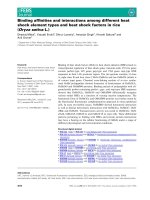
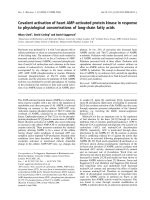
![Chemical and functional components in different parts of rough rice (oryza sativa l[1] ) beforeandaftergermination](https://media.store123doc.com/images/document/14/rc/qa/medium_qab1394872940.jpg)
